Unit 5 First Aid Listening
文档属性
| 名称 | Unit 5 First Aid Listening | 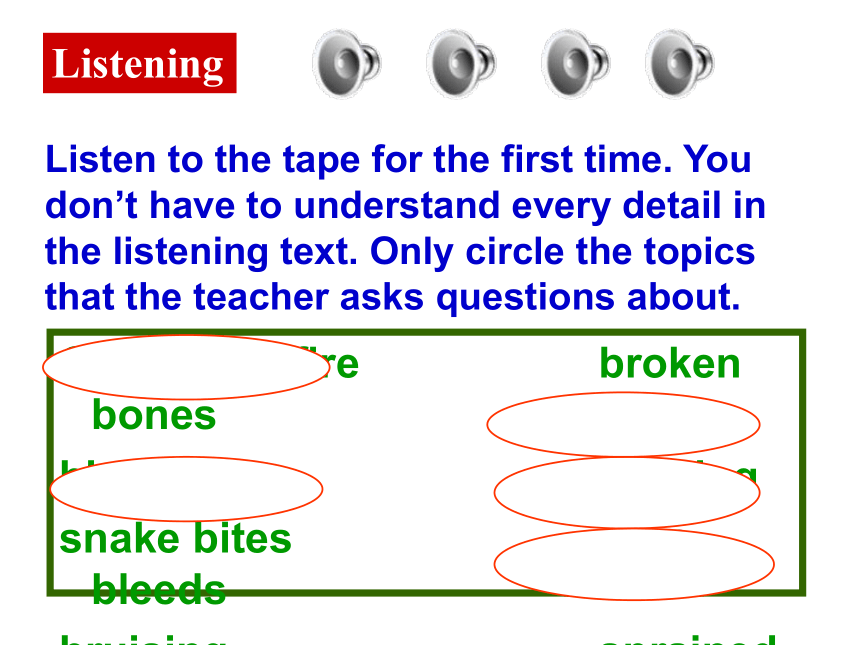 | |
| 格式 | rar | ||
| 文件大小 | 1.2MB | ||
| 资源类型 | 教案 | ||
| 版本资源 | 人教版(新课程标准) | ||
| 科目 | 英语 | ||
| 更新时间 | 2009-10-31 08:56:00 | ||
图片预览

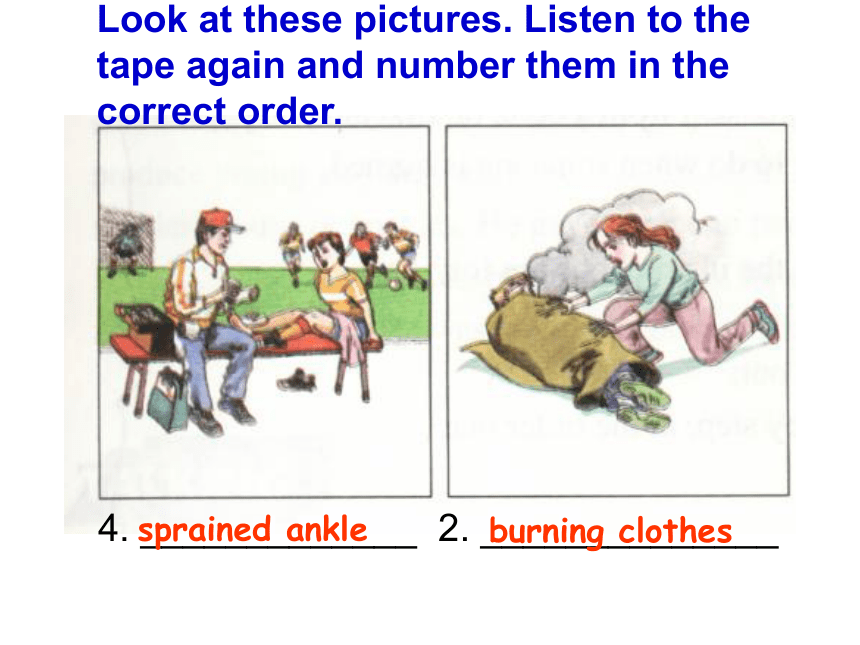
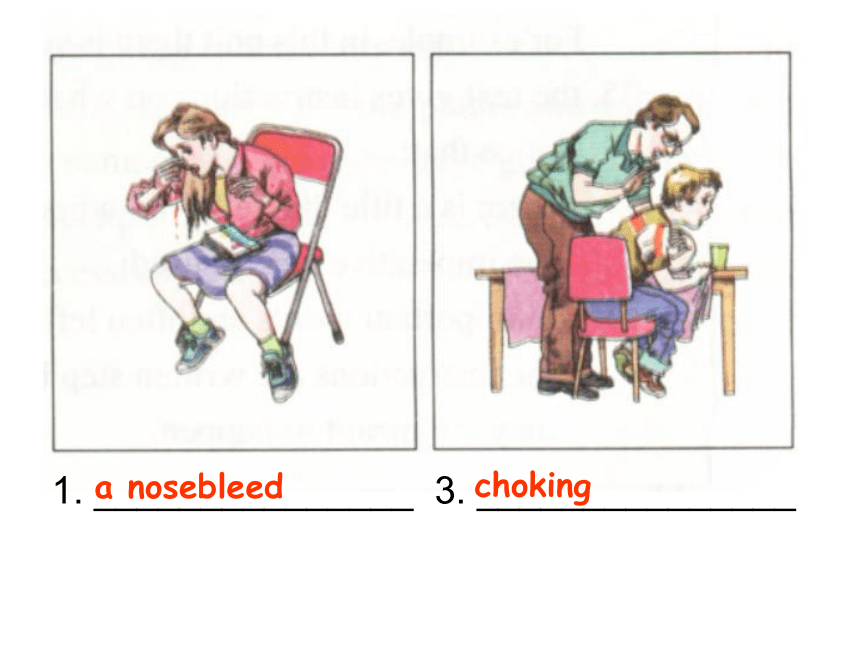
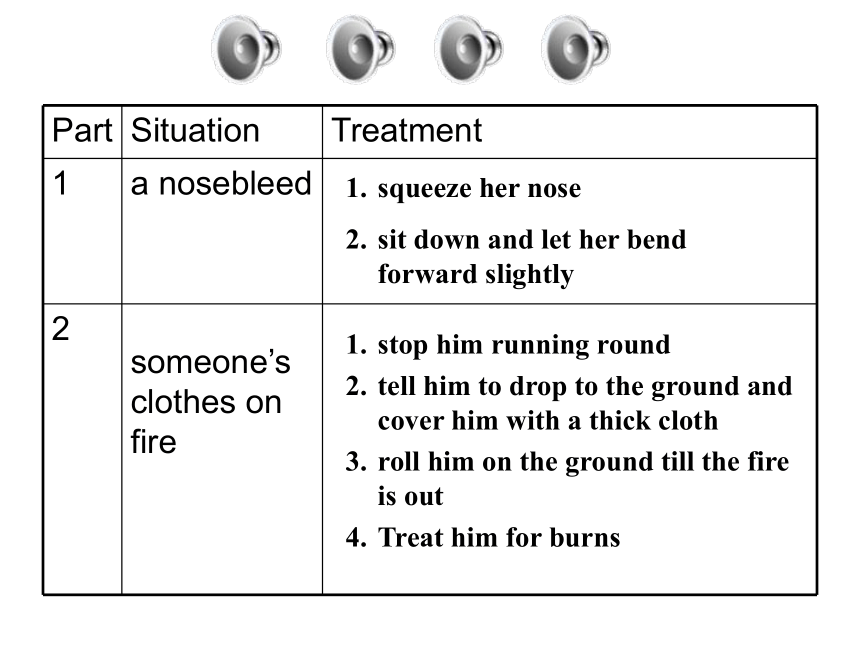
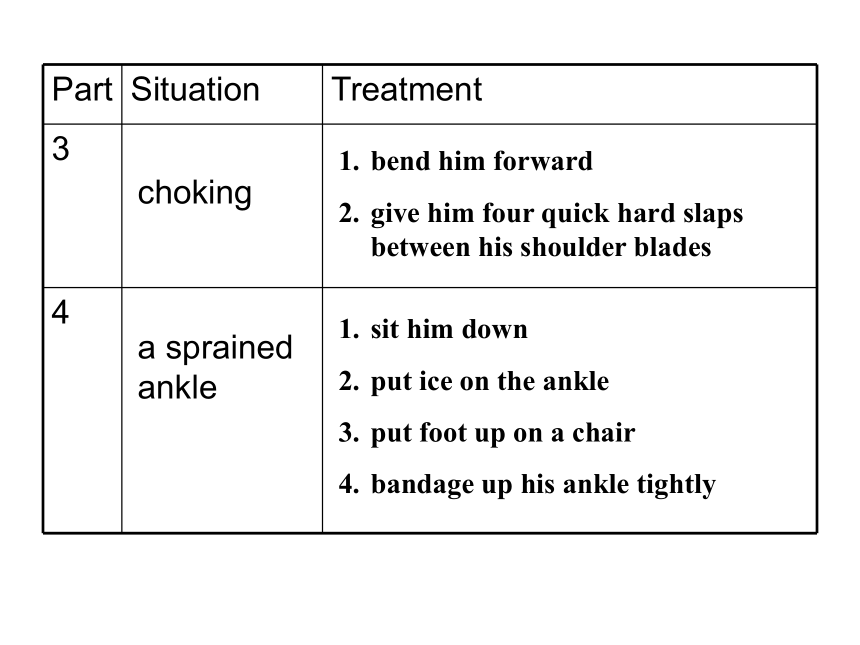
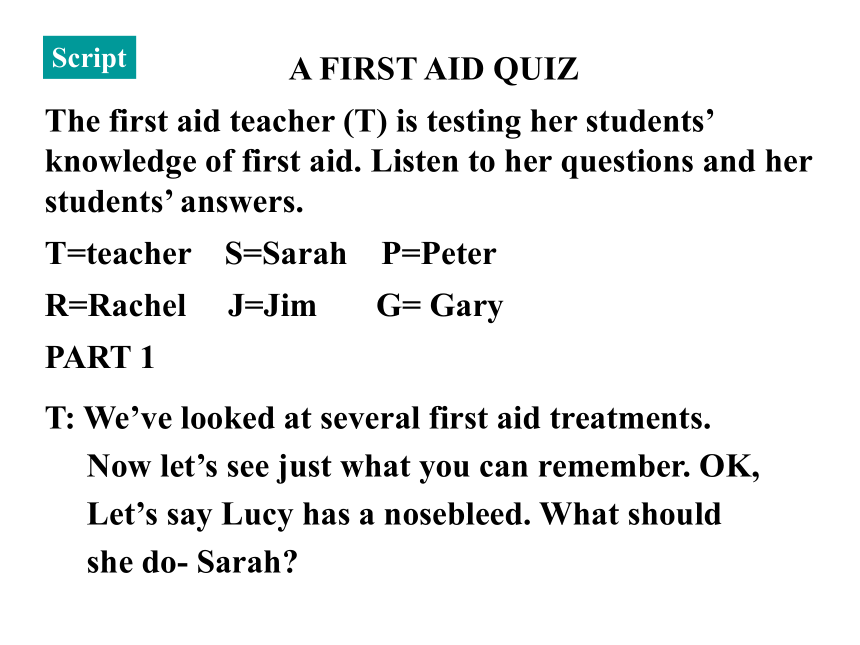
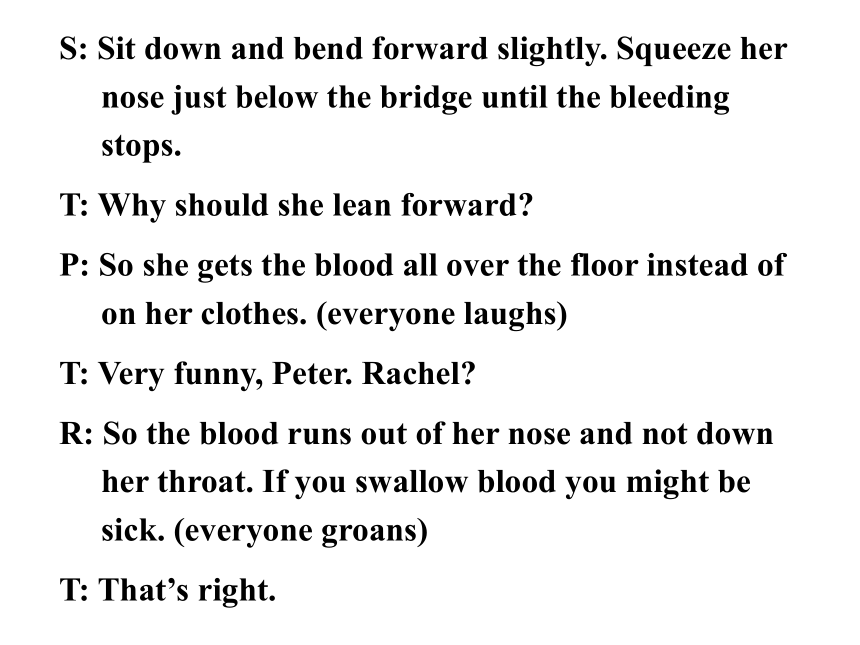
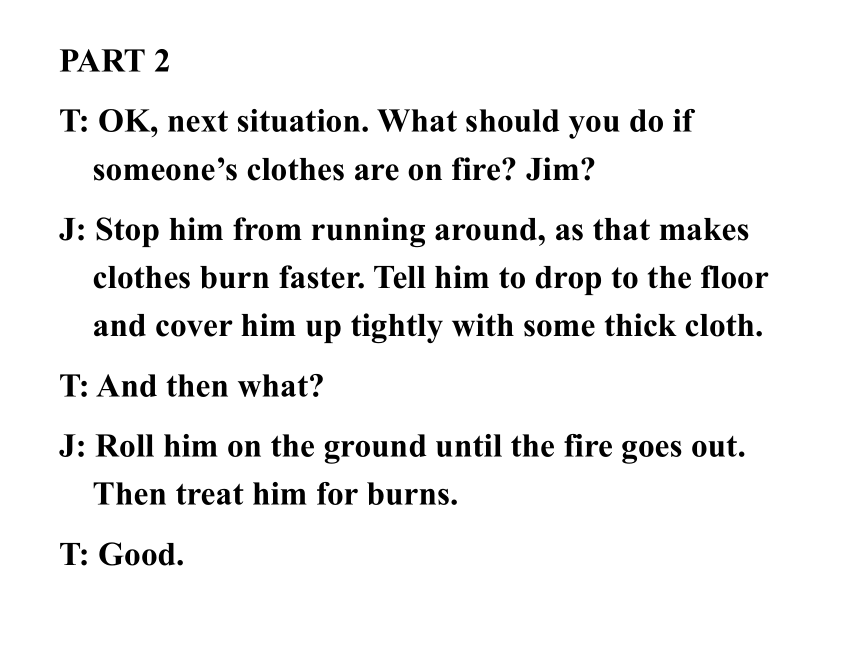
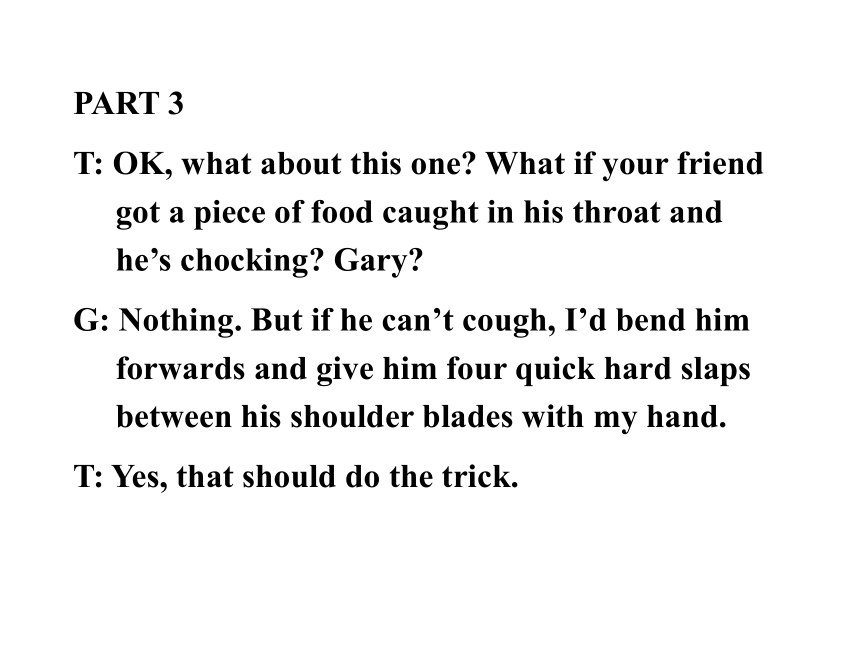
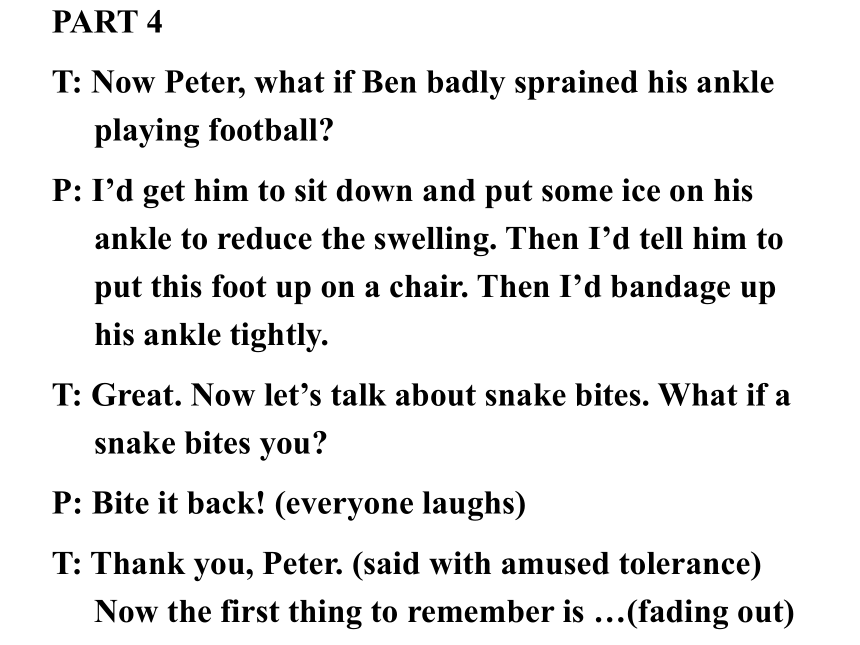
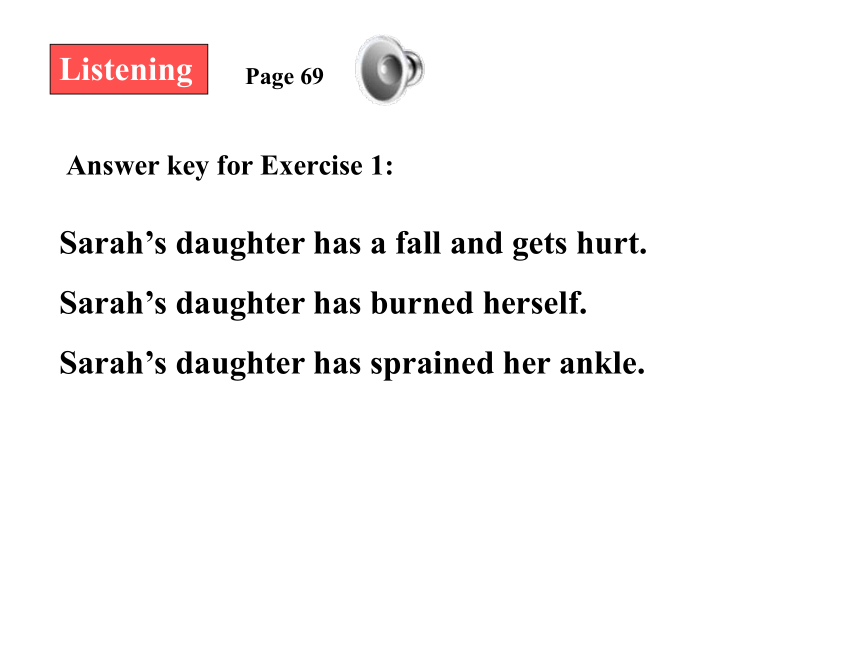
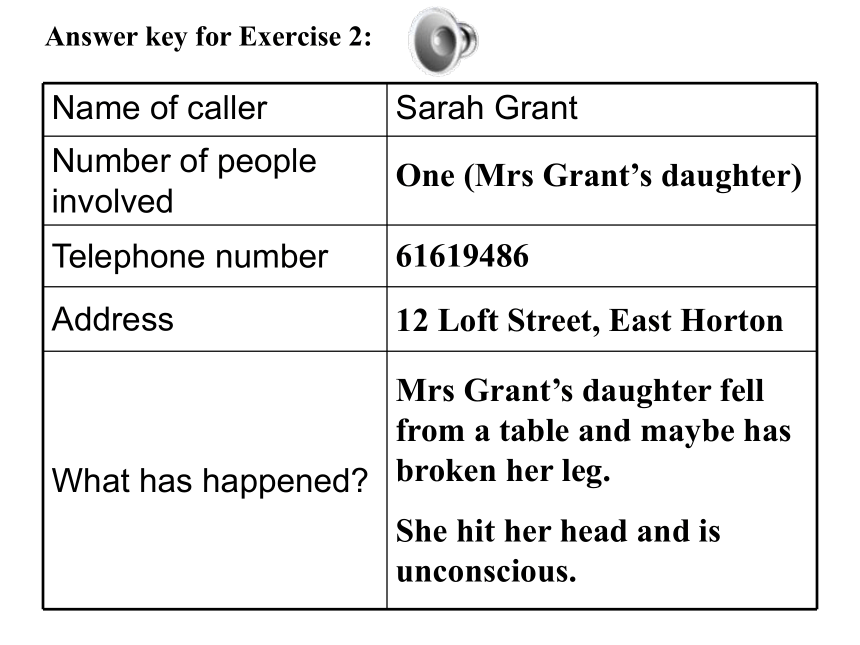
文档简介
课件32张PPT。Clothes on fire broken bones
bleeding choking
snake bites nose bleeds
bruising sprained ankleListen to the tape for the first time. You don’t have to understand every detail in the listening text. Only circle the topics that the teacher asks questions about.ListeningLook at these pictures. Listen to the tape again and number them in the correct order.
4. _____________ 2. ______________sprained ankleburning clothes1. _______________ 3. _______________a nosebleedchokingsqueeze her nose
sit down and let her bend forward slightlystop him running round
tell him to drop to the ground and cover him with a thick cloth
roll him on the ground till the fire is out
Treat him for burnssomeone’s clothes on firebend him forward
give him four quick hard slaps between his shoulder bladessit him down
put ice on the ankle
put foot up on a chair
bandage up his ankle tightlychokinga sprained ankleA FIRST AID QUIZ
The first aid teacher (T) is testing her students’ knowledge of first aid. Listen to her questions and her students’ answers.
T=teacher S=Sarah P=Peter
R=Rachel J=Jim G= GaryPART 1
T: We’ve looked at several first aid treatments. Now let’s see just what you can remember. OK, Let’s say Lucy has a nosebleed. What should she do- Sarah?ScriptS: Sit down and bend forward slightly. Squeeze her nose just below the bridge until the bleeding stops.
T: Why should she lean forward?
P: So she gets the blood all over the floor instead of on her clothes. (everyone laughs)
T: Very funny, Peter. Rachel?
R: So the blood runs out of her nose and not down her throat. If you swallow blood you might be sick. (everyone groans)
T: That’s right.PART 2
T: OK, next situation. What should you do if someone’s clothes are on fire? Jim?
J: Stop him from running around, as that makes clothes burn faster. Tell him to drop to the floor and cover him up tightly with some thick cloth.
T: And then what?
J: Roll him on the ground until the fire goes out. Then treat him for burns.
T: Good.PART 3
T: OK, what about this one? What if your friend got a piece of food caught in his throat and he’s chocking? Gary?
G: Nothing. But if he can’t cough, I’d bend him forwards and give him four quick hard slaps between his shoulder blades with my hand.
T: Yes, that should do the trick.PART 4
T: Now Peter, what if Ben badly sprained his ankle playing football?
P: I’d get him to sit down and put some ice on his ankle to reduce the swelling. Then I’d tell him to put this foot up on a chair. Then I’d bandage up his ankle tightly.
T: Great. Now let’s talk about snake bites. What if a snake bites you?
P: Bite it back! (everyone laughs)
T: Thank you, Peter. (said with amused tolerance) Now the first thing to remember is …(fading out)Sarah’s daughter has a fall and gets hurt.
Sarah’s daughter has burned herself.
Sarah’s daughter has sprained her ankle.Answer key for Exercise 1:Listening Page 69One (Mrs Grant’s daughter)6161948612 Loft Street, East HortonMrs Grant’s daughter fell from a table and maybe has broken her leg.
She hit her head and is unconscious.Answer key for Exercise 2:The operator sounds calm and efficient.
Sarah Grant sounds worried, frightened and panicky.
The operator asks Sarah to speak slowly and take deep breaths.
The operator could have advised Sarah Grant not to move her daughter and to keep her warm by putting a blanket over her.Answer key for exercise 3:Suggested answers to Exercise 4:She could have given her daughter a ladder to stand on as this is more secure than a table. She could have put the items in a lower cupboard and somewhere that was easy to reach.AN EMERGENCY CALL
Mrs Grant (G) is ringing the emergency number. Her daughter has had an accident in the kitchen and is unconscious. Listen to the phone conversation with the operator (O)O: Emergency. Can I help you?
G: You’ve got to help me – my daughter’s had an accident, I don’t know what to do.
O: Now calm down. Tell me your name and phone number – slowly.
G: Ummm … Sarah Grant. Oh, you’ve got to send an ambulance now.
O: Yes, I will. Now take a deep breath and tell me your phone number.ScriptG: Yes, yes … 61619486.
O: Good. Now tell me what’s happened.
G: Well, my daughter was standing on a table in the kitchen and was reaching up to the top cupboard and she fell. Now she’s on the floor. Her leg looks strange- maybe it’s broken. And she hit her head – she’s unconscious. I’ve shouted at her but she won’t wake up. Oh, please hurry.
O: Yes, we will …
G: Oh thank you, thank you, Goodbye …O: (interrupts) No, no, don’t hang up … we need your address.
G: Oh, sorry, I’m just so worried. It’s 12 Loft Street, East Horton.
O: OK. 12 Loft Street, East Horton?
G: Yes, yes! Please be quick.
O: Right. The ambulance is on its way.
G: Thanks so much. Goodbye.
O: Goodbye.Look at the pictures and then listen to Parts 1 and 2. Number the boxes to show the correct order of the pictures.71234568Listening task 12 1 check if conscious 2 put into recovery position4 3 clear airway 4 check if breathing35 blow into mouth and watch for breating 6 check pulse5677 continue rescure8 put into recovery position8Check whether unconscious
Put into recovery position
Check and clear airway
Check for breathing
Blow into mouth
Check pulse
Continue rescue breathing at 15 breaths a minute
When breathing again, put in recovery positionAnswer key for Exercise 3:RESCUE BREATHING
A first aid teacher is revising rescue breathing with her class.
T= teacher L= Lucy P= Peter E= EileenPART 1
T: Now class, what must we do before rescue breathing?
L: We must check if the person is unconscious.
T: How do we do that?ScriptL: We shake them. If there’s no movement we know her or she is unconscious.
T: Yes, that’s right, Lucy. Anything else?
P: We can also ask simple questions like “What’s your name?” or “Open your eyes please!”
T: Exactly right, Peter. If the person doesn’t move or answer then they’re unconscious. Now how do we put the person in a recovery position?E: I know this. First, you put one arm straight out on the ground and bend the other arm across the chest. Second, you roll the person over onto their side. Third, bend the near leg up.
T: Excellent, Eileen. What do you do to the head?
E: You tilt the head backwards and turn the face downwards a bit.
T: Why?E: To let any liquid run out of the mouth and allow the tongue to fall forward.
T: Good, Eileen.
T: Now what’s next, Peter?
P: We must clear the airway from the mouth to the lungs. We can use our fingers inside the mouth.
T: Why?
P: So we can check for breathing by seeing if the chest is rising and falling.PART 2
T: And…
P: And we put our cheek close to the face to feel if there’s any air coming from the nose or mouth.
T: Well done, Peter. But what if the person isn’t breathing?
L: You must start rescue breathing.
T: That’s right. Lucy. What should we do?L: Roll the person onto their back. Tilt the head back. Squeeze the nose to stop air coming out. Place your mouth over the person’s mouth. Blow into the mouth for up to two seconds. Watch the chest rise and fall. Take another breath and blow into her mouth again.
T: How long should you do this?L: About 15 breaths a minute. After about a minute check the pulse and breathing again. Continue this process until the person breathes or medical help arrives.
T: What would you do if breathing begins?
L: Put the person in the recovery position. If there’s no breathing then continue breathing for them.
T: Well done, all of you . You remembered very well.Speaking TaskC
A
C
A
BD
D
A
C
D
CMake a speech (first aid )What should you do in the following situations?1 Your little brother is bitten by a big dog.
2 Your mother burned herself while she was cooking for you.
3 You found your classmate cut himself with a knife.
4.You found a person bleeding badly on the road.
5. You found a person unconscious on your way home.First , …
Second, …
Third, …
Finally, …
bleeding choking
snake bites nose bleeds
bruising sprained ankleListen to the tape for the first time. You don’t have to understand every detail in the listening text. Only circle the topics that the teacher asks questions about.ListeningLook at these pictures. Listen to the tape again and number them in the correct order.
4. _____________ 2. ______________sprained ankleburning clothes1. _______________ 3. _______________a nosebleedchokingsqueeze her nose
sit down and let her bend forward slightlystop him running round
tell him to drop to the ground and cover him with a thick cloth
roll him on the ground till the fire is out
Treat him for burnssomeone’s clothes on firebend him forward
give him four quick hard slaps between his shoulder bladessit him down
put ice on the ankle
put foot up on a chair
bandage up his ankle tightlychokinga sprained ankleA FIRST AID QUIZ
The first aid teacher (T) is testing her students’ knowledge of first aid. Listen to her questions and her students’ answers.
T=teacher S=Sarah P=Peter
R=Rachel J=Jim G= GaryPART 1
T: We’ve looked at several first aid treatments. Now let’s see just what you can remember. OK, Let’s say Lucy has a nosebleed. What should she do- Sarah?ScriptS: Sit down and bend forward slightly. Squeeze her nose just below the bridge until the bleeding stops.
T: Why should she lean forward?
P: So she gets the blood all over the floor instead of on her clothes. (everyone laughs)
T: Very funny, Peter. Rachel?
R: So the blood runs out of her nose and not down her throat. If you swallow blood you might be sick. (everyone groans)
T: That’s right.PART 2
T: OK, next situation. What should you do if someone’s clothes are on fire? Jim?
J: Stop him from running around, as that makes clothes burn faster. Tell him to drop to the floor and cover him up tightly with some thick cloth.
T: And then what?
J: Roll him on the ground until the fire goes out. Then treat him for burns.
T: Good.PART 3
T: OK, what about this one? What if your friend got a piece of food caught in his throat and he’s chocking? Gary?
G: Nothing. But if he can’t cough, I’d bend him forwards and give him four quick hard slaps between his shoulder blades with my hand.
T: Yes, that should do the trick.PART 4
T: Now Peter, what if Ben badly sprained his ankle playing football?
P: I’d get him to sit down and put some ice on his ankle to reduce the swelling. Then I’d tell him to put this foot up on a chair. Then I’d bandage up his ankle tightly.
T: Great. Now let’s talk about snake bites. What if a snake bites you?
P: Bite it back! (everyone laughs)
T: Thank you, Peter. (said with amused tolerance) Now the first thing to remember is …(fading out)Sarah’s daughter has a fall and gets hurt.
Sarah’s daughter has burned herself.
Sarah’s daughter has sprained her ankle.Answer key for Exercise 1:Listening Page 69One (Mrs Grant’s daughter)6161948612 Loft Street, East HortonMrs Grant’s daughter fell from a table and maybe has broken her leg.
She hit her head and is unconscious.Answer key for Exercise 2:The operator sounds calm and efficient.
Sarah Grant sounds worried, frightened and panicky.
The operator asks Sarah to speak slowly and take deep breaths.
The operator could have advised Sarah Grant not to move her daughter and to keep her warm by putting a blanket over her.Answer key for exercise 3:Suggested answers to Exercise 4:She could have given her daughter a ladder to stand on as this is more secure than a table. She could have put the items in a lower cupboard and somewhere that was easy to reach.AN EMERGENCY CALL
Mrs Grant (G) is ringing the emergency number. Her daughter has had an accident in the kitchen and is unconscious. Listen to the phone conversation with the operator (O)O: Emergency. Can I help you?
G: You’ve got to help me – my daughter’s had an accident, I don’t know what to do.
O: Now calm down. Tell me your name and phone number – slowly.
G: Ummm … Sarah Grant. Oh, you’ve got to send an ambulance now.
O: Yes, I will. Now take a deep breath and tell me your phone number.ScriptG: Yes, yes … 61619486.
O: Good. Now tell me what’s happened.
G: Well, my daughter was standing on a table in the kitchen and was reaching up to the top cupboard and she fell. Now she’s on the floor. Her leg looks strange- maybe it’s broken. And she hit her head – she’s unconscious. I’ve shouted at her but she won’t wake up. Oh, please hurry.
O: Yes, we will …
G: Oh thank you, thank you, Goodbye …O: (interrupts) No, no, don’t hang up … we need your address.
G: Oh, sorry, I’m just so worried. It’s 12 Loft Street, East Horton.
O: OK. 12 Loft Street, East Horton?
G: Yes, yes! Please be quick.
O: Right. The ambulance is on its way.
G: Thanks so much. Goodbye.
O: Goodbye.Look at the pictures and then listen to Parts 1 and 2. Number the boxes to show the correct order of the pictures.71234568Listening task 12 1 check if conscious 2 put into recovery position4 3 clear airway 4 check if breathing35 blow into mouth and watch for breating 6 check pulse5677 continue rescure8 put into recovery position8Check whether unconscious
Put into recovery position
Check and clear airway
Check for breathing
Blow into mouth
Check pulse
Continue rescue breathing at 15 breaths a minute
When breathing again, put in recovery positionAnswer key for Exercise 3:RESCUE BREATHING
A first aid teacher is revising rescue breathing with her class.
T= teacher L= Lucy P= Peter E= EileenPART 1
T: Now class, what must we do before rescue breathing?
L: We must check if the person is unconscious.
T: How do we do that?ScriptL: We shake them. If there’s no movement we know her or she is unconscious.
T: Yes, that’s right, Lucy. Anything else?
P: We can also ask simple questions like “What’s your name?” or “Open your eyes please!”
T: Exactly right, Peter. If the person doesn’t move or answer then they’re unconscious. Now how do we put the person in a recovery position?E: I know this. First, you put one arm straight out on the ground and bend the other arm across the chest. Second, you roll the person over onto their side. Third, bend the near leg up.
T: Excellent, Eileen. What do you do to the head?
E: You tilt the head backwards and turn the face downwards a bit.
T: Why?E: To let any liquid run out of the mouth and allow the tongue to fall forward.
T: Good, Eileen.
T: Now what’s next, Peter?
P: We must clear the airway from the mouth to the lungs. We can use our fingers inside the mouth.
T: Why?
P: So we can check for breathing by seeing if the chest is rising and falling.PART 2
T: And…
P: And we put our cheek close to the face to feel if there’s any air coming from the nose or mouth.
T: Well done, Peter. But what if the person isn’t breathing?
L: You must start rescue breathing.
T: That’s right. Lucy. What should we do?L: Roll the person onto their back. Tilt the head back. Squeeze the nose to stop air coming out. Place your mouth over the person’s mouth. Blow into the mouth for up to two seconds. Watch the chest rise and fall. Take another breath and blow into her mouth again.
T: How long should you do this?L: About 15 breaths a minute. After about a minute check the pulse and breathing again. Continue this process until the person breathes or medical help arrives.
T: What would you do if breathing begins?
L: Put the person in the recovery position. If there’s no breathing then continue breathing for them.
T: Well done, all of you . You remembered very well.Speaking TaskC
A
C
A
BD
D
A
C
D
CMake a speech (first aid )What should you do in the following situations?1 Your little brother is bitten by a big dog.
2 Your mother burned herself while she was cooking for you.
3 You found your classmate cut himself with a knife.
4.You found a person bleeding badly on the road.
5. You found a person unconscious on your way home.First , …
Second, …
Third, …
Finally, …
